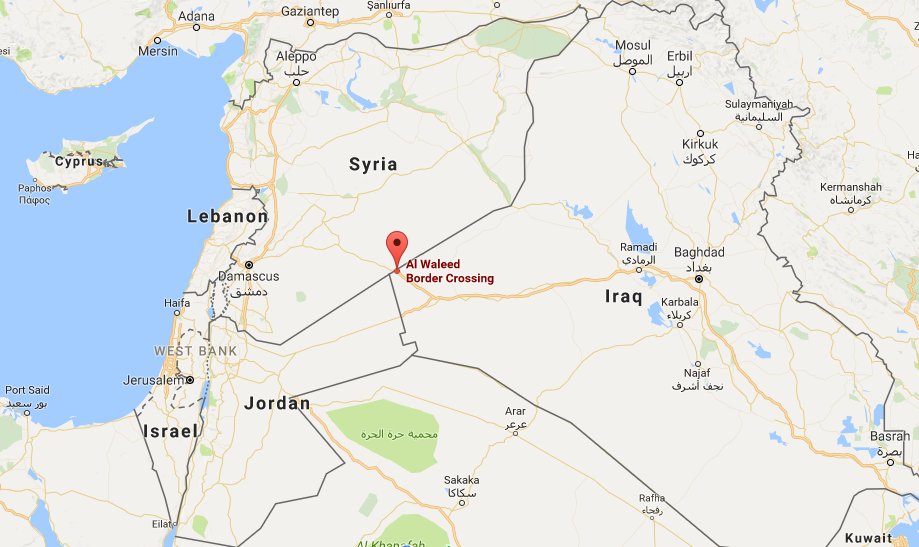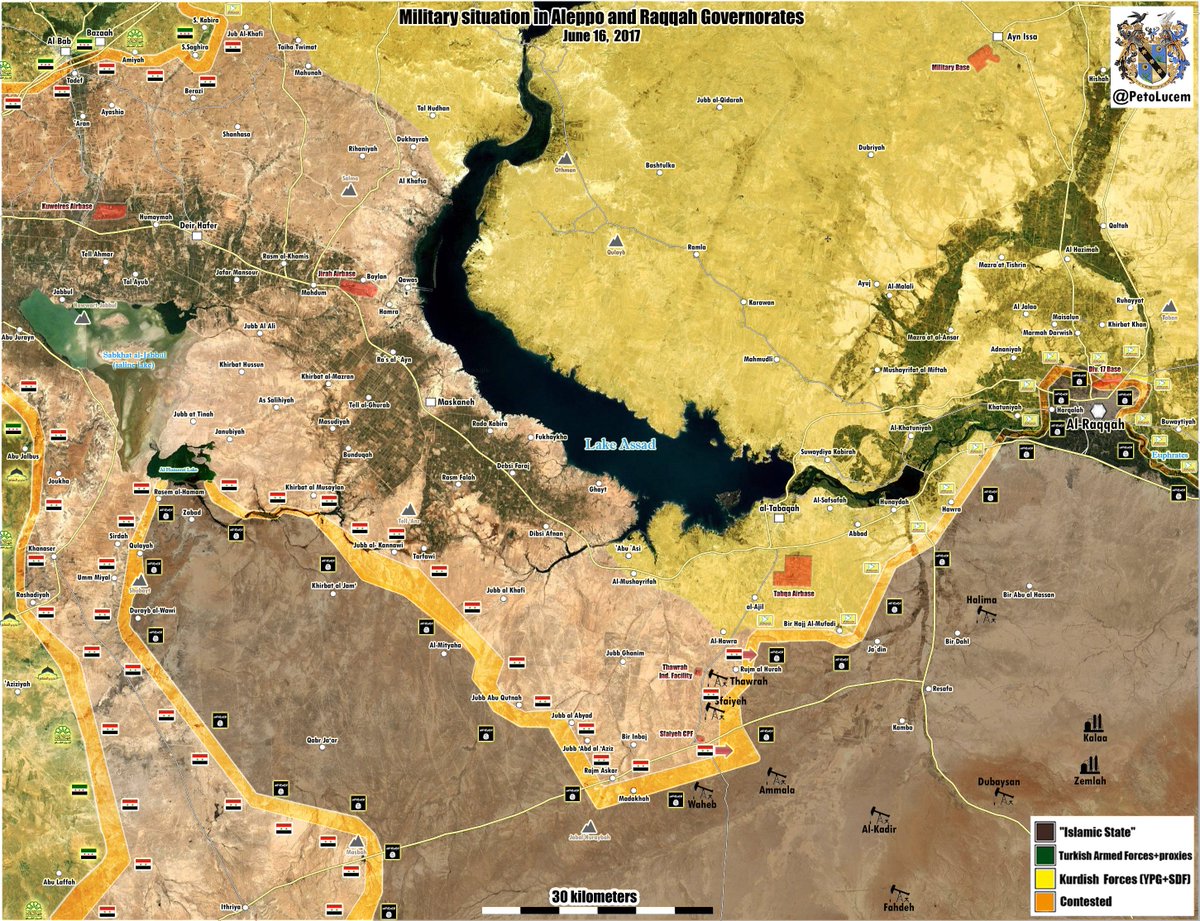Ilmeisesti jenkit esti jonkun korkean profiilin isis komentajan kohdistuneen iskun.
Yrittivät pommittaa jenkkien tukemia joukkoja. Mistä sait päähäsi tuon isis jutun?
Follow along with the video below to see how to install our site as a web app on your home screen.
Note: This feature may not be available in some browsers.
Ilmeisesti jenkit esti jonkun korkean profiilin isis komentajan kohdistuneen iskun.
Oliko Jenkkien turva-alueen sisällä? Reilussa viikossa monta yhteenottoa Usan ja Iranin välillä. Sodassa ne on vaikka siinä joku Assad on muodollisesti välissä-.
Edit:Olihan taas suoja-alueella. Venäläisillekin soiteltiin.

Suomen Sotilas
6 mins ·
Lentotukialus USS George H.W. Bushilta operoinut Boeing F/A-18 Super Hornet ampui Syyrian ilmavoimien Suhoi Su-22 -hävittäjäpommittajan Ja'Dinin kylän lähellä Syyriassa.
Pudotus on ensimmäinen Super Hornet -tyyppisen koneen ilmataisteluvoitto.
18.6. klo 16:30 Syyrian al-Assadin hallituksen joukot olivat valmistelemassa hyökkäystä Ja'Din -nimisen kylän suuntaan, joka on Yhdysvaltojen ja kansainvälisen liittouman tukemien Syrian Democratic Forces (SDF) -joukkojen hallussa. Liittouman lentokoneet tekivät voimannäyttö -lennon alueelle hyökkäyksen pysäyttämiseksi, mikä tuntui auttaneen.
Syyrian konfliktin hidastamiseksi Yhdysvaltojen johtaman liittouman on ollut tapana ilmoittaa kuumalla linjalla al-Assadia tukeville venäläisille joukoille varoitus mahdollisen yhteenoton välttämiseksi. Tästä huolimatta Syyrian ilmavoimien Su-22 -koneet ilmaantuivat alueelle ja alkoivat pommittaa SDF:n joukkoja. Seurauksena Yhdysvaltojen laivaston Super Hornet puuttui tilanteeseen ja ampui yhden Su-22 -koneen alas.
//pm

Heh.. Kunhan ymmärtävät että Sukhoit tulevat tonttiin samalla hetkellä kun avaavat tulen liittouman koneita vastaan. Alueellahan on Hornettien lisäksi myös Raptoreita suojaamassa. Mahtava soppahan siitä sakenee, mutta huvittavaa että ryssät antavat ymmärtää kaikkien olevan heille vapaata tykinruokaa. Tällä kertaa saalis taitaa vain olla kohtuu myrkyllinen.Venäjä on nyt hyvin, hyvin vihainen eilisestä syyrialaiskoneen pudotuksesta. Venäjä on ilmoittanut lakkauttavansa kommunikoinnin Yhdysvaltojen kanssa Syyrian yllä tapahtuvista lennoista ja katsoo vihamielisiksi kaiken ilmailutoiminnan alueilla, joilla Venäjän oma ilmatoiminta on aktiivista.
Soppa sakenee.
Noniin nyt se foliohattu pois päästäIlmeisesti jenkit esti jonkun korkean profiilin isis komentajan kohdistuneen iskun.

Mutta kun Venäjän ja Syyrian hallinnon viralliset lähteet ovat kertoneet syyrialaiskoneen olleen pommittamassa ISIStä kun se ammuttiin alas, niin täytyyhän sen olla totta. Eiväthän nuo ikinä valehtelisi...Noniin nyt se foliohattu pois päästä

Noniin nyt se foliohattu pois päästä
A U.S. Navy Fighter Jet Just Shot Down a Syrian Warplane
Su-22 had bombed U.S. allies in Syria

WIB airWIB front June 18, 2017 Sebastien Roblin 1
Syria37
For nearly three years, Syrian, Russian and U.S. war planes have maintained an uneasy truce over Syria — a truce that progressively frayed early-to-mid 2017. But the main parties had so far refrained from engaging each other in air-to-air combat.
That all changed at 6:00 in the evening, local time, on June 18, 2017, when a U.S. Navy F/A-18E Super Hornet fighter shot down a Syrian air force Su-22 attack jet — the first manned airplane the United States had shot down in aerial combat since 1999.
Earlier at around 4:30 that afternoon, Syrian ground forces attacked the Kurdish-led Syrian Democratic Forces in the town of Ja’Din, south of the city of Tabqah. SDF forces had captured Tabqah from Islamic State on May 10, 2017. Only 34 miles away from the ISIS capital of Raqqa, Tabqah is a staging ground for the ground assault on the ISIS capital.
The Syrian government attack on June 18 wounded several SDF fighters and caused them to withdraw from the Ja’Din. Coalition fighters then performed a “show of force” to dissuade the attackers. This was likely a low-level overflight of the Syrian troops.
One month earlier on May 18, 2017, U.S. aircraft performed a show-of-force over a Syrian armored column advancing toward an SDF training camp.
But the column kept rolling, so the U.S. jets attacked, destroying a tank and some construction vehicles and forcing the convoy to halt. Then on June 8, a Syrian drone — likely of Iranian manufacture — launched a failed attack on rebel forces being trained by U.S. advisors. A U.S. Air Force F-15E Strike Eagle fighter subsequently shot down the drone before it could release additional weapons.
This Su-22M-3 of No. 677 Squadron survived the attack on Shayrat. Photo via Yalla Souriya
The initial aerial show of force on June 18 was reportedly successful in causing the Syrian forces to disengage. Afterward, U.S. forces communicated with their Russian counterparts via their shared “deconfliction hotline” in the hope of de-escalating the situation.
However, at 6:43 that evening, a Syrian Su-22 dropped bombs on SDF forces in the city of Tabqah itself. According to U.S. Combined Joint Task force “in accordance with the rules of engagement and in collective self-defense of coalition partnered forces, [the Su-22] was immediately shot down by a U.S. F/A-18E Super Hornet.”
The Su-22 is the workhorse of the Syrian air force. It’s a large, fast, swing-wing ground-attack plane. Though capable of carrying heavy bomb loads, it can only employ short-range air-to-air missiles and its cannons in aerial combat. It would have been easy prey for the more advanced Super Hornet fighter, which boasts a powerful radar and long-range AIM-120 air-to-air missiles.
In fact, the Su-22 the Americans shot down on June 18 was not the first Su-22 destroyed by coalition forces in Syria. On April 4, 2017, Syrian Su-22s dropped chemical munitions on the Syrian city of Khan Sheikhoun. In retaliation, Pres. Donald Trump ordered a Tomahawk cruise missile strike on Shayrat airfield, where the Su-22s were based.
Although Moscow claimed that no Su-22s had been hit in the missile strike, photographic evidence subsequently revealed that at least four of the planes had been destroyed.
The aerial clash on June 18 could further strain the uneasy truce between the U.S.-led anti-ISIS coalition and Syrian government forces backed by Russian air power and Iranian advisors. The United States has strengthened its alliance with the Kurdish-led SDF as the rebel army embarks on a ground offensive to capture the ISIS capital of Raqqa.
Syrian ground crew arms an Su-22. Photo via A.V.
At the same time, the Syrian government forces have launched more and more attacks on SDF troops in the last month. Fighting between the two had previously been limited because the SDF focused on fighting ISIS, while the Syrian government concentrated on crushing moderate rebel groups that posed a more direct threat to the regime.
Now that both ISIS and the moderate opposition are meeting defeat after defeat on the battlefield, Damascus appears to be seeking out confrontations with the Kurds. For now, the U.S.-led coalition is doing its best to downplay the consequences of the aerial skirmish.
“The coalition’s mission is to defeat ISIS in Iraq and Syria,” it stated. “The coalition does not seek to fight Syrian regime, Russian or pro-regime forces partnered with them.” However, “demonstrated hostile intent and actions of pro-regime forces toward coalition and partner forces in Syria conducting legitimate counter-ISIS operations will not be tolerated.”
It remains to be seen how this incident will impact Russia’s ongoing aerial operations over Syria. In November 2015, two Turkish F-16 fighters shot down a Russian Su-24 bomber after it briefly crossed into Turkish airspace. The incident led to a sharp — though short-lived — decline in Russian-Turkish relations, and ultimately led to the establishment of the de-confliction process to avoid future incidents.
Unfortunately, the de-confliction process today was clearly ineffective.
“The coalition calls on all parties to focus their effort on the defeat of ISIS,” U.S.-led forces stated. However, even as ISIS forces appear on the verge of defeat in both Syria and Iraq, the truce between the anti-ISIS coalition, the Syrian government and Russia seems more fragile than ever.
Niin, nyt taitaa olla Venäjällä ennen kaikkea puheet kovia, mutta varsinaiset teot voivat jäädä vähäisemmälle tasolle. Kumpikaan osapuoli, Venäjä tai US, tuskin haluavat isompaa yhteenottoa keskenään. Toisaalta US ei varmaankaan lentelyä tuolla alueella lopeta. Ja Yhdysvaltalaisen koneen kimppuun käyminen tuolla alueella tarkoittaa ISOA ongelmaa venäläisille. Venäjän pitää nyt kasvojensa säilyttämiseksi käyttää kovaa retoriikkaa. Ja lentely alueella jatkuu kuten ennenkin.Heh.. Kunhan ymmärtävät että Sukhoit tulevat tonttiin samalla hetkellä kun avaavat tulen liittouman koneita vastaan. Alueellahan on Hornettien lisäksi myös Raptoreita suojaamassa. Mahtava soppahan siitä sakenee, mutta huvittavaa että ryssät antavat ymmärtää kaikkien olevan heille vapaata tykinruokaa. Tällä kertaa saalis taitaa vain olla kohtuu myrkyllinen.
